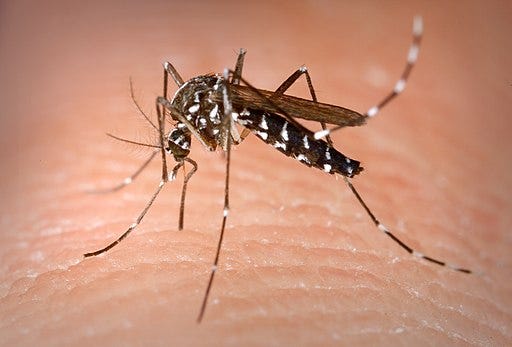1 Week, 7 Stories #29
Back to the moon, back to the office, and we’re back into mosquito season.
Every edition features 7 stories, from the past week. I’ll draw on my background in media, journalism, agriculture, biotech, and renewable energy to come up with an interesting selection and to offer some context.
Sometimes built around a theme, sometimes random, but with a Canadian twist.
This week I’m leading with a story that is not truly a last week story, but close enough because as regular readers know, I have a soft spot for the iconic caribou.
Read on
Caribou herds cut a swath through Canada. Starting in the high Arctic and subarctic, caribou populations arc down through the Northwest Territories and Yukon, through British Columbia, and on to Alberta and Saskatchewan, across the middle of Manitoba and continue through Ontario, Quebec, and up into Newfoundland and Labrador. They are all under threat to some extent.
Caribou populations need help to give them a fighting chance and after being shut out for too long, Indigenous communities are playing a key role in planning and managing the herds. Following a significant drop in caribou numbers in 2014, the Government of Nunavut enlisted hunting and trapping organizations in Iqaluit, Pangnirtung, Qikiqtarjuaq, Kimmirut and Kinngait to better understand the decline and said there are now some positive signs for the South Baffin herd.
In late May, the Government of Alberta announced in a media release that it had partnered with the Fort McKay First Nation and the Athabasca Landing Métis Community Association to help restore caribou habitat in the northern part of the province where the Woodland caribou are listed as a threatened species. The project will incorporate Indigenous perspectives into helping the caribou population and much of the planning will be led by the Indigenous community. While a positive step, both Alberta and Ontario seem to be lagging behind in efforts to restore boreal caribou according to the latest federal report.
Apart from illegal hunting and human destruction of habitats, climate change once again enters the picture as a threat to caribou. Warmer winters are ideal for deer populations and white-tailed deer are moving farther north where they are out competing woodland caribou.
For a look at the future of caribou check one of my favourite sources for northern news - Cabin Radio.
Rejection is an ongoing obstacle in organ transplants. The donor organ is seen as a foreign object and the recipient’s body attacks it. The rejection is treated with immunosuppressants which also lowers the patient’s resistance to other infections. If the rejection becomes chronic, the patient is faced with a long-term problem.
With funding from Genome British Columbia, Genome Canada, and BC Transplant, researchers are turning to genetic testing to minimize the problem in kidney transplants. To match donors with recipients the current practice is to look at blood type and test for antibodies that could lead to the one in three transplants that fail – usually because of rejection. With new genetic sequencing technology that can be completed in about 6 hours, not only can the match be more precise, but immunosuppressants can be tailored to each patient.
This is a significant development beyond the human-to-human or animal to person transplants such as the genetically-edited pig kidney given to a 62-year old man in March. He has since died. A woman who received a similar transplant in April, had the new kidney removed this week because it was not functioning as hoped. There is also a new therapeutic treatment being studied to assess its potential in treating rejection, but unlike the genetic research it is still after the fact and is more of a one-size-fits-all approach.
There are 3,000 people in Canada on the waiting list for a new kidney and that waitlist can be a few months to a few years depending on the availability of a donor-patient match. The new first of its kind genetic sequencing approach could change the nature of that waitlist. With more precise matching some people may move up the list, which means some people move down.
If this new research proves to be successful however, it can be applied to other organ donations and ultimately mean a better chance of success for all recipients.
The meteorological start of summer was June 1st and the astronomical start of summer is not until June 20th this year. Why the difference? AccuWeather summed it up for us last week.
Whenever you peg your start of summer though, we are heading into mosquito season. Male mosquitoes live less than a week, but it is the females that bite and they can buzz around for 6 weeks or so. The little insect has had 100 million years or so to evolve into making the most of wet environments and every year we contemplate how big a supply of repellent we need to have at the ready.
In a story on the Toronto.com website, a University of Ottawa associate professor said that the changing climate is leading to milder winters and earlier thaws which means that bugs – including mosquitoes – get out and about sooner. But mosquitoes require standing water to reproduce and in places like Manitoba where dry conditions are sucking up the rainfall mosquito breeding conditions are not ideal for the short term at least. Meanwhile in Ottawa, 166.1 millimetres of precipitation in April and May and a lack of spring frost means swatting is already the norm. Despite recent rainfall, Alberta is still experiencing overall drought conditions so local conditions will be the biggest factor. The latest mosquito count in Saskatoon is down from last year and from the 10 year average.
79 mosquito species are now considered native to Canada though even some of those may have been imported here hundred of years ago when colonization started. One species however is getting extra attention this year because of its invasive nature. The tiger mosquito (so named because of its colour – not its size!) is native to southeast Asia and transmits the West Nile, dengue, and chikungunya viruses. The Public Health Agency of Canada and Let’s Talk Science have teamed up for a citizen science study to help in identifying where the Aedes albopictus is settling into its new Canadian territory.
Time to prepare for the inevitable. Get rid of standing water around your home, check your window and door screens to keep the pests from buzzing around inside, and wear long-sleeved shirts and pants if you are going to be in mosquito country. Or just hide in the basement!
And if you wonder where the mosquito got its name, listen up.
When I was young, we gathered at my grandparent’s house to watch the first manned mission to land on the moon. Those early live pictures beamed back to earth were in black and white, but my grandparents had colour TV, so it was exciting to have that added dimension around the broadcasting team and live shots of Mission Control. That was July 20th, 1969. There were 5 more crewed missions with the last one in 1972. No human has stepped foot on the lunar surface since.
This week I watched a Washington Post live webcast with the 4 astronauts who will be on the Artemis 2 mission scheduled to orbit the moon next year as the first step to put mere earthlings onto the lunar surface once again.
It is part of the new Space Age as the Washington Post headlined it earlier this year.
After watching the webcast (here is the recording) and starting to investigate some of the topics that came up, I ended up with a subsection of this edition of 1 Week, 7 Stories.
Space News
The biggest news has to be the successful launch of the much delayed Boeing Starliner on Wednesday morning. It still must dock with the International Space Station on Thursday and then safely return the 2 crew members back to earth on June 14th to call the mission a success, but the first hurdle has been passed. Assuming all goes according to plan the Boeing craft will be the second astronaut transport vehicle for NASA. (the other the Space X Crew Dragon capsule)
-
Less encouraging is the latest news on the Hubble Space Telescope. The automated space observatory has sent back remarkable images and data to earth for 34 years, but it is showing signs of ageing. At a press conference this week, NASA said one of its three remaining gyroscopes has failed. The telescope will operate with just one gyroscope and keep the other in stand-by mode as a reserve unit. The gyroscopes are the only way to aim and lock onto targets. The new plan to operate with just one unit will limit its capabilities but NASA says they believe they can continue to operate well into the 2030s.
-
This week the Chinese Chang’e 6 spacecraft landed on the far side of the moon, scooped up 2 kg (4.4 lbs) of lunar material and placed it into an ascent module which took off and will transfer the sample to a return module already orbiting the moon. That module is scheduled to parachute into the desserts of Mongolia on June 25th.
-
In February Intuitive Machines' commercial Odysseus moon lander made a soft landing on the surface of the moon but tipped over and ended up on its side – thought it sill managed to transmit data back to earth. However the company learned from the experience and has announced some changes to its second lunar lander which will launch later this year.
-
Finally in space news, as more countries want to head to the moon and beyond, and commercial space ventures disrupt the economics of space exploration, researchers want to see the environments of Mars and Moon protected. Authors of a new paper published in the journal Space Policy say that the “environments of the Moon and Mars are at risk of being irreversibly altered by human activity” and that sustainability should be a core principle of space exploration and policies.
A few years ago, the idea of wastewater surveillance was a footnote when it came to public health, but the COVID-19 pandemic changed that. Sampling wastewater quickly became an efficient tool to track the presence and spread of COVID-19 and its variants. It even became kind on an early warning system because the virus was shed by people before they exhibited any symptoms. An online COVID-19 wastewater monitoring dashboard was created and is still active today. Soon however there will be a hole in the data because the Ontario government announced this week it is shutting down its monitoring program – in the very province where it began in Canada. The decision to end the program at the end of July comes despite its proven success and runs contrary to what many other jurisdictions are doing.
COVID may not be the threat it was but it has not gone away – including in Ontario where the Halton region had an average of 25 cases per week in April and May and only 5% of adults in the region are up-to-date on their COVID vaccinations. There is even a new variant being reported in the US.
Wastewater surveillance is not just a tool to track COVID. The American Council on Science and Health said this week that it can be used to monitor the spread of H5N1 avian flu, a practice that is already happening in parts of Canada. In Alberta a spinoff from monitoring for viruses are results that can measure illicit drug use.
Wastewater monitoring is an important public health tool. It can track harmful chemicals, drugs, and viruses regionally and locally. Ontario’s decision may prove to be shortsighted.
My taste in soft drinks has been justified. I prefer a cold Dr Pepper over a Coke or Pepsi. (However I do like Diet Dr Pepper as well which is frowned upon by many Pepper people).
While Coke still leads the pack in market percentage by volume, Dr Pepper has finally passed Pepsi as the drink of choice in the US market. This despite the fact that overall growth by volume is expected to shrink slightly by 2025. (Revenue in 2023 was up because of higher prices by the way)
The latest news on the Dr Pepper gains means an opportunity for investors – albeit not a market beating stock. It has proven it can continue to compete and there is plenty of room for international sales growth.
Dr Pepper has always had the image of being an outsider in the soft drink race because it is hard to categorize. It is not a cola or root beer, nor is it an energy drink, and over the years it has built up a unique consumer following. Those followers have ensured the drink does not suffer the fate of Tab, New Coke, Crystal Pepsi, Slice, and a few other soft drinks that started with a splash and disappeared in a trickle.
According to the Dr Pepper Museum it was the brainchild of Texas pharmacist Charles Alderton. It was first sold in Morrison’s Old Corner Drug Store in Waco, Texas in 1885, which gives it a 1-year jump on Coke and a few years before Pepsi. Originally there was a period after Dr but as there never was a real Dr. Pepper and to make advertising and labelling easier, the punctuation disappeared in the 1950s. After changing ownership several times since its drug store days, it has ended up in the Keurig Dr Pepper product group, which includes Canada Dry.
A can of Dr Pepper contains 29mg of caffeine compared to 33mg in a can of Coke and there is no aspartame-free version available in Canada as there is in the US. As Pepper fans have tried to guess the ingredients and the 23 flavours that go into the drink, the rumour spread that prune juice was a key component. Dr Pepper Canada says no prune juice.
Dr Pepper is surely an oddball drink and if you are looking for “The most asked question in human history”, Dr Pepper Canada will take you down the rabbit hole.
1970’s Dr Pepper commercial featuring actor David Naughton.
In early May the federal government released details about its plans to bring employees back into the office three days a week. Public sectors unions were caught off guard and said there was no consultation prior to the announcement and unions promised a “summer of discontent” over the policy. A hint of that discontent might be showing through in a survey conducted in Gatineau, Quebec which is home to a number of federal offices. Among those surveyed only 24% supported the government’s plan according to a CBC story.
After having a taste of work-from-home and hybrid workplaces during the pandemic those federal workers are not alone. A survey in May by ResumeBuilder.com in the US found that half of the companies in the survey now require staff to be in the office 4 or 5 days a week. However, 8 in 10 companies also admit to losing some staff because of return-to-office policies. Companies cite productivity concerns and improving company culture as the main reasons for calling employees back into the office fold. Staff don’t seem to agree according to another survey (here a survey, there a survey!!). Workers think it is all about control.
Hardline policies are not proving to be successful (just ask Elon Musk) while flexibility and good employer-employee communication are more likely to win the corporate day.
Read, comment, subscribe, and share this newsletter.
I’m available for contract and freelance work with not-for-profits and charities. With 40 years of experience behind me and lots of time ahead of me, I’m here to help you make a difference in your media relations, public relations, and general communications needs.




